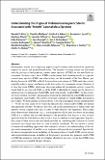Files in this item
Understanding the origins of problem geomagnetic storms associated with "stealth" coronal mass ejections
Item metadata
| dc.contributor.author | Nitta, Nariaki V | |
| dc.contributor.author | Mulligan, Tamitha | |
| dc.contributor.author | Kilpua, Emilia K J | |
| dc.contributor.author | Lynch, Benjamin J | |
| dc.contributor.author | Mierla, Marilena | |
| dc.contributor.author | O'Kane, Jennifer | |
| dc.contributor.author | Pagano, Paolo | |
| dc.contributor.author | Palmerio, Erika | |
| dc.contributor.author | Pomoell, Jens | |
| dc.contributor.author | Richardson, Ian R | |
| dc.contributor.author | Rodriguez, Luciano | |
| dc.contributor.author | Rouillard, Alexis P | |
| dc.contributor.author | Sinha, Suvadip | |
| dc.contributor.author | Srivastava, Nandita | |
| dc.contributor.author | Talpeanu, Dana-Camelia | |
| dc.contributor.author | Yardley, Stephanie L | |
| dc.contributor.author | Zhukov, Andrei N | |
| dc.date.accessioned | 2022-01-10T12:30:15Z | |
| dc.date.available | 2022-01-10T12:30:15Z | |
| dc.date.issued | 2021-12 | |
| dc.identifier | 277402084 | |
| dc.identifier | ace96fec-c684-46b5-a1fa-52bab09bbd46 | |
| dc.identifier | 85118743114 | |
| dc.identifier | 000714371100001 | |
| dc.identifier.citation | Nitta , N V , Mulligan , T , Kilpua , E K J , Lynch , B J , Mierla , M , O'Kane , J , Pagano , P , Palmerio , E , Pomoell , J , Richardson , I R , Rodriguez , L , Rouillard , A P , Sinha , S , Srivastava , N , Talpeanu , D-C , Yardley , S L & Zhukov , A N 2021 , ' Understanding the origins of problem geomagnetic storms associated with "stealth" coronal mass ejections ' , Space Science Reviews , vol. 217 , no. 8 , 82 . https://doi.org/10.1007/s11214-021-00857-0 | en |
| dc.identifier.issn | 0038-6308 | |
| dc.identifier.other | Jisc: 872daa8ba0694291af224b4d2140de08 | |
| dc.identifier.other | pmcid: PMC8566663 | |
| dc.identifier.other | pmid: 34789949 | |
| dc.identifier.uri | https://hdl.handle.net/10023/24624 | |
| dc.description | Funding: This work was supported by NASA AIA contract NNG04EA00C, and NRL STEREO/SECCHI contracts N00173-15-C-2016 and N00173-19-C-2011, all to LMSAL. N.V.N. and T.M. were supported by NASA grant NNX17AB73G. E.K.J.K. and J.P. acknowledge the Finnish Centre of Excellence in Research of Sustainable Space (FORESAIL; Academy of Finland grant no. 312390), and the European Union’s Horizon 2020 Research and Innovation Programme Project 724391 (SolMAG). E.K.J.K. also acknowledges Academy of Finland Project 310445 (SMASH). B.J.L. acknowledges support from NASA 80NSSC19K0088 and NSF AGS 1851945. M.M., L.R., D.-C.T., and A.N.Z. thank the European Space Agency (ESA) and the Belgian Federal Science Policy Office (BELSPO) for their support in the framework of the PRODEX Programme. E.P. is supported by the NASA Living With a Star (LWS) Jack Eddy Postdoctoral Fellowship Program, administered by UCAR’s Cooperative Programs for the Advancement of Earth System Science (CPAESS) under award no. NNX16AK22G. I.G.R. acknowledges support from the ACE and STEREO missions and NASA program NNH17ZDA001N-LWS. D.-C.T. was funded by the Ph.D. fellowship of the Research Foundation – Flanders (FWO), contract no. 1118920N. S.L.Y. would like to acknowledge STFC for support via the consolidated grant SMC1/YST037 and NERC for funding via the SWIMMR Aviation Risk and Modelling (SWARM) Project, grant no. NE/V002899/1. | en |
| dc.description.abstract | Geomagnetic storms are an important aspect of space weather and can result in significant impacts on space- and ground-based assets. The majority of strong storms are associated with the passage of interplanetary coronal mass ejections (ICMEs) in the near-Earth environment. In many cases, these ICMEs can be traced back unambiguously to a specific coronal mass ejection (CME) and solar activity on the frontside of the Sun. Hence, predicting the arrival of ICMEs at Earth from routine observations of CMEs and solar activity currently makes a major contribution to the forecasting of geomagnetic storms. However, it is clear that some ICMEs, which may also cause enhanced geomagnetic activity, cannot be traced back to an observed CME, or, if the CME is identified, its origin may be elusive or ambiguous in coronal images. Such CMEs have been termed "stealth CMEs". In this review, we focus on these "problem" geomagnetic storms in the sense that the solar/CME precursors are enigmatic and stealthy. We start by reviewing evidence for stealth CMEs discussed in past studies. We then identify several moderate to strong geomagnetic storms (minimum Dst | |
| dc.format.extent | 53 | |
| dc.format.extent | 22696943 | |
| dc.language.iso | eng | |
| dc.relation.ispartof | Space Science Reviews | en |
| dc.subject | Coronal Mass Ejections | en |
| dc.subject | Space Weather | en |
| dc.subject | Magnetic Storms | en |
| dc.subject | Low-Coronal Signatures | en |
| dc.subject | QB Astronomy | en |
| dc.subject | QC Physics | en |
| dc.subject | 3rd-DAS | en |
| dc.subject.lcc | QB | en |
| dc.subject.lcc | QC | en |
| dc.title | Understanding the origins of problem geomagnetic storms associated with "stealth" coronal mass ejections | en |
| dc.type | Journal article | en |
| dc.contributor.sponsor | Science & Technology Facilities Council | en |
| dc.contributor.institution | University of St Andrews. Statistics | en |
| dc.contributor.institution | University of St Andrews. Applied Mathematics | en |
| dc.identifier.doi | 10.1007/s11214-021-00857-0 | |
| dc.description.status | Peer reviewed | en |
| dc.identifier.grantnumber | ST/S000402/1 | en |
This item appears in the following Collection(s)
Items in the St Andrews Research Repository are protected by copyright, with all rights reserved, unless otherwise indicated.

